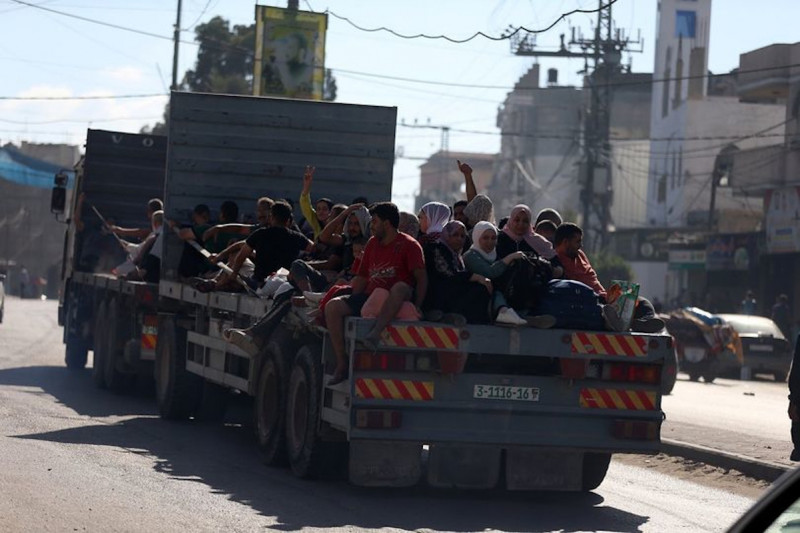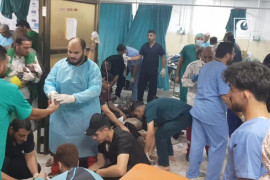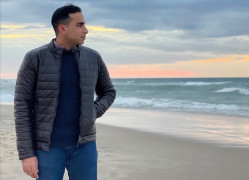Chronicles from hell
A Second Nakba: Echoes of the 1948 Exodus
Gaza's civilians are torn between fleeing south or staying in their homes. Older people recall that the tactics Israel is using are the same ones it employed during the first catastrophe
Mahmoud Mushtaha Gaza City , 11/11/2023

A large number of citizens were displaced to places south of the Gaza Strip. They were targeted by Israeli airstrikes. / Mohammed Zannoun
En CTXT podemos mantener nuestra radical independencia gracias a que las suscripciones suponen el 70% de los ingresos. No aceptamos “noticias” patrocinadas y apenas tenemos publicidad. Si puedes apoyarnos desde 3 euros mensuales, suscribete aquí
Amidst the ongoing attack, the Israeli occupation forces persist in launching relentless assaults on the Gaza Strip, perpetrating numerous civilian massacres and acts of genocide, tragically resulting in a death toll of 11,091. On November 10, the Israeli army attacked Al Shifa hospital, the largest in Gaza, where thousands of people were sheltering. According to Gazan authorities, other hospitals are under siege by tanks. Concurrently, Israel intensifies fear by issuing warnings and intimidating the residents of Gaza City, urging them to evacuate and relocate southward.
Forced to seek safety for himself and 45 members of his family, 73-year-old Abu Sameh Esleem had no choice but to evacuate his home and embark on a five-kilometer journey on foot. “Along the way, the entire landscape of Al-Zahra city in South Gaza unfolded, with all its buildings erased as if they had never existed.”
“We were inside our residence at Al-Zahraa Towers when I gathered all my children and grandchildren from their homes in various nearby areas, driven by a deep sense of fear for their safety. Abruptly, Israeli airstrikes commenced, targeting the towers—approximately 23 in total—and now, all of them lie in ruins,” the old man said.
The Esleem family was compelled to leave their homes due to Israeli airstrikes targeting them at night. Forced to walk into the unknown through perilous paths, they eventually reached Al-Shifa Hospital. Upon learning of the approaching Israeli tanks near Al-Shifa Hospital, they also left on foot to reach UNRWA schools in the east of Gaza, Abu Sameh explained.
Despite the continuous warnings of the Israeli forces and the perpetration of dozens of massacres and exterminations against civilians, some of them refused to leave their homes to prevent a second Nakba to a happen.
Survived the Nakba in 1948, Witnessing another in 2023
Mohammad Ashraf, 82, experienced the Nakba in 1948. He reflects, “The identical events from 1948 are unfolding once again. Israel is executing massacres with the aim of forcing us to abandon our homes, mirroring the tactics used during the Nakba. Back then, they perpetrated massacres in villages to instill fear, compelling residents to flee to other countries.”
The perspectives from the elderly who lived through historical injustices and from the young grappling with the present-day nightmare emphasize the intergenerational trauma inflicted upon the Palestinian people
“My thoughts are consumed by the plight of the children and women who endure these unbearable conditions. Every generation of the Palestinian people has faced the atrocities of the occupation. I never anticipated that the suffering and displacement I witnessed with my grandfather would now be experienced by my own grandchildren,” Mohammed said.
Taking on a different perspective, Abdullah Nasrallah, a young man in his twenties, finds himself traversing a path in Gaza that is merely about survival rather than pursuing the dreams he once envisioned for himself.
“My grandmother always told me about the Nakba and their migration in 1948, but I had never imagined living the details that she would inform me about. My mind is unable to comprehend the events and suffering that we are experiencing, I have survived death twice,” Abdullah told.
The perspectives, one from the elderly who lived through historical injustices and the other from the younger generation grappling with the present-day nightmare, emphasize the intergenerational trauma inflicted upon the Palestinian people. Abdullah Nasrallah's heartbreaking wish for death as an escape from the current suffering underscores the severity of the situation.
While he was grieving, he said, “Today, I am living the most difficult day in my life. Today was more difficult for me than death. I wish I had died not to live through this suffering and humiliation. All we hoped for was that this nightmare would end.”
While Israel asserts the establishment of a safe corridor for civilians to travel from north to south, the Euro-Med Human Rights Monitor has countered this claim, stating that the Israeli army's announcement of a safe passage is a strategic military tactic employed to target Palestinian civilians.
The Israeli army, according to the Euro-Med Human Rights Monitor, is exerting pressure on residents in the city and its northern regions to vacate their residential areas, directing them toward the central and southern areas of the Gaza Strip. The so-called "corridor" is said to be designated along the main traffic artery, Salah al-Din Road, during specific hours from 9:00 to 16:00.
Amidst the ongoing attack, the Israeli occupation forces persist in launching relentless assaults on the Gaza Strip, perpetrating numerous civilian massacres and acts of genocide, tragically resulting in a death toll of 11,091. On November 10, the Israeli army attacked Al Shifa hospital, the largest in Gaza,...
Autor >
Suscríbete a CTXT
Orgullosas
de llegar tarde
a las últimas noticias
Gracias a tu suscripción podemos ejercer un periodismo público y en libertad.
¿Quieres suscribirte a CTXT por solo 6 euros al mes? Pulsa aquí








